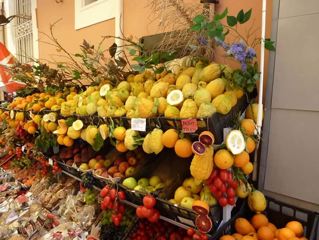 We’ve discussed the importance of eating food choices from the “rainbow of color” options out there, but some readers wrote in asking for even more specifics than we have previously listed in various blog posts.
We’ve discussed the importance of eating food choices from the “rainbow of color” options out there, but some readers wrote in asking for even more specifics than we have previously listed in various blog posts.
Although within the US we have moved from using a model of a food guide pyramid to using a model of a plate to encourage healthful choices in dining, there are still some useful pyramid options out there.
(Fresh Produce on Display in Taormina, Sicily, Italy, graphic courtesy of Betty H)
The “Mediterranean Diet” (general Mediterranean style dietary intake as part of a total lifestyle) visualized as a food guide pyramid is one example; and an anti-inflammatory pyramid popularized by Dr. Andrew Weil is another example.
For infotainment purposes only, we’ll share some anti-inflammatory food item options in the following listing, which is by no means all-inclusive, but should give you the gist of the breadth and depth of wonderful food source options that have been reported to have some anti-inflammatory properties. A dietetic colleague, John S. Pasztor, MPH, RD, CDE, over at the The Regional Diabetes and Endocrine Center, Cape Fear Valley Health System, gladly shares another version of a list from 2009 with his patients and with members of a dietetic practice group one of us belongs to.
We have used for inspiration bits and pieces of various skeleton listings out there and then come up with our own fleshed out infotainment version, subject to change/further updating, which follows. Research is ongoing and some items will show up on one list, but not another, in various reviews of research, so realize the list* is always subject to modification/updating as newer research results are reported and older results further clarified.
There is no one “Mediterranean Diet” pattern per se. The exact composition of any Mediterranean style of dietary intake varies throughout that area of the world, depending upon what historically was or presently is available in any specific locale there.
The “Mediterranean” actually covers a wide expanse of ~15 nations and within those nations are many regions, each with specific food item sources that could be grown, fished, or otherwise obtained via trade between those respective locales bordering the beautiful Mediterranean Sea.
*SOME ANTI-INFLAMMATORY FOOD SOURCES
BEANS/LEGUMES:
- Black Beans
- Garbanzo Beans (aka Chickpeas)
- ?Kidney Beans
- Lima Beans,
- Navy Beans
- ?Peas, dried
- Pinto Beans
- Soybeans (scroll down to bottom of page)
BEVERAGES:
- Certain tea leaf teas such as green, oolong, and white
- Hot Cocoa (100% natural processed WITHOUT alkali–avoid Dutch processing with alkali cocoa); some > 70% cacao content dark chocolate
FISH:
- Cod (especially Asian Black)
- Halibut
- Herring
- Oyster
- Rainbow Trout
- Sablefish
- Salmon (Alaskan, wild sockeye)
- Sardines
- Snapper Fish
- Striped Bass
- Tuna
- Whitefish

FRUITS: (aim for Organic when feasible); Fresh in Season, Frozen out of season
&
VEGETABLES: (aim for Organic when feasible); Fresh in Season, Frozen or Canned (no added salt) out of season
(Farmers Market in Ljubljana, Slovenia, graphic courtesy of Betty H)
- Alliums (Garlic, Leeks, Onions of all sorts including Green Onion scapes/shoots through Shallots)
- Apples
- Avocados
- Beets and Beet Greens
- Bell Peppers, sweet (green, orange, red, yellow)
- Blackberries
- Black Currants
- Blueberries
- Bok Choy
- Broccoli
- Broccoli Rabe
- Brussels Sprouts
- Cabbage (napa, red, white)
- ?Cantaloupe
- Carrots
- Cauliflower (in Fall look for the variety that goes from royal purple to royal blue when cooked)
- Cherries
- Collard Greens
- Chili Pepper, fresh (the “hotter” the chili pepper, the greater its capsaicin content such as “hotter” varieties of habanero and Scotch bonnet)
- Cranberries
- Fennel
- Garlic including Garlic Scapes
- Green Beans
- Green Onions
- Grapes, red/purple (and those turned into red wine–no more than 1-2 glasses/day) or dark Raisins
- Grapefuit, pink
- Guavas
- Kale
- Kiwis
- Kumquats
- Leeks
- Lemons
- Limes
- ?Mangoes
- Mulberries
- Mushrooms (Asian, cooked, examples include enokidake, maitake, oyster, shiitake)
- Mustard Greens
- Nectarines
- Olives and pressed olive oils (think Extra Virgin Olive Oil)
- Onions
- Oranges
- Papayas
- Peaches
- Peapods (Chinese snow peas pea pods, sugar snap pea pods)
- Pears
- Pineapples, fresh, ripe
- Plums/Prunes
- Pomegranates
- Pumpkin
- Raspberries
- Rhubarb
- Sea Vegetables (such as Nori seaweed)
- Shallots
- Spinach
- Squashes, winter
- Strawberries
- Sweet Potatoes
- Swiss Chard
- Tomatoes, ripe
- Turnip Greens
- Watercress
GRAINS:
- Whole +/or Cracked, including grains made into pasta cooked al dente, etc. (assuming there is no gluten sensitivity, which would mean limiting the choices)
HERBS AND SPICES:
- Basil
- Black Pepper (contains piperine, which helps enhance the absorption of the curcumin in turmeric)
- Cayenne Pepper
- Chili Pepper, dried
- Cinnamon
- Cloves
- Ginger
- Licorice
- Mint
- Mustard Seeds
- Oregano
- Parsley
- Rosemary
- Sage
- Thyme
- Turmeric
NUTS AND SEEDS:
- Almonds
- Brazil Nuts
- Cashews
- Chia Seeds (whole or soaked to form a gel)
- Flaxseeds (Ground) and Flaxseed Oil aka Linseed Oil
- Hazelnuts
- Hemp Seeds
- Sunflower Seeds
- Walnuts
OILS:
- Avocado oil
- Canola Oil (expeller-pressed)
- Extra Virgin Olive Oil
SOY:
- Edamame, miso, soymilk, soy nuts, tempeh, tofu (some studies suggest up to 1-2 servings/day)
Life doesn’t come with guarantees, so no one can promise what health benefits you might obtain from changing your dietary intake. We all have different genetics and epigenetic influences (even identical twins and triplets aren’t truly identical in terms of a lifetime of epigenetic influences on their genes).
Nonetheless, you just might find that eating more of the food sources in a “Mediterranean Style Diet” to be to your liking and that of your body’s as well.

